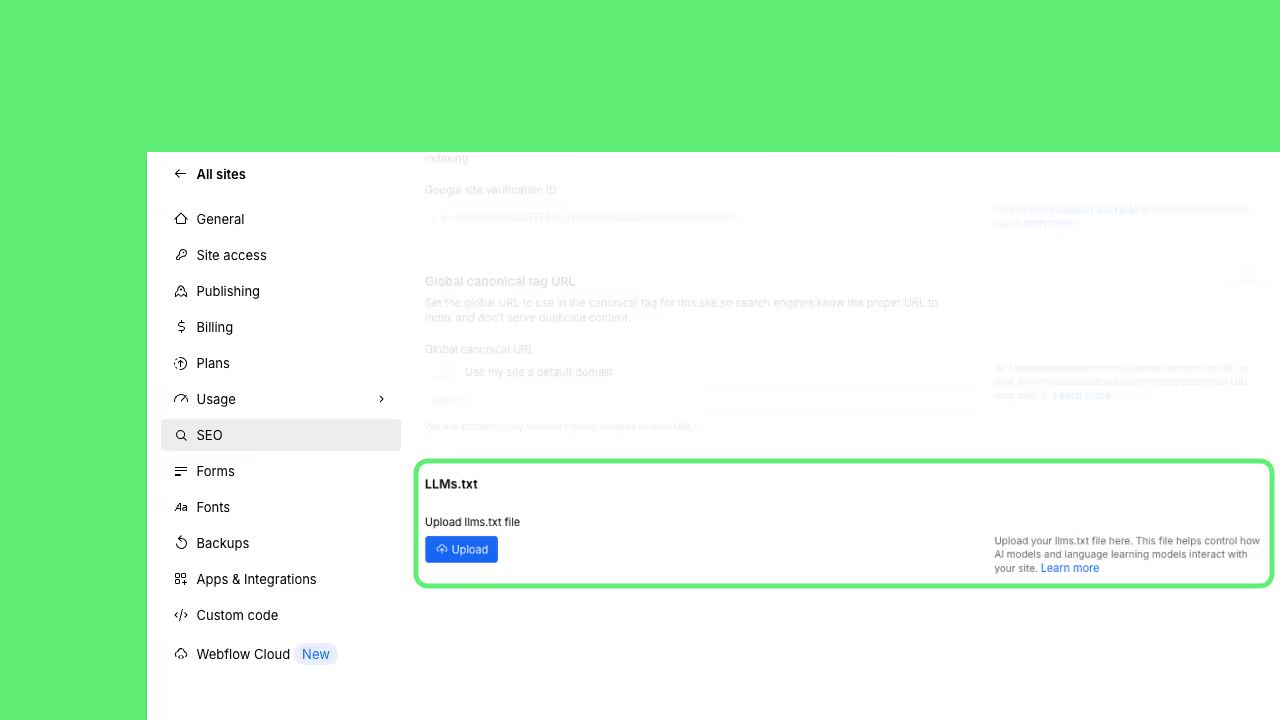Imagine having your website explored every day by thousands of generative AIs that use your content to answer user questions, without you having any control over this interaction. That's exactly what's happening today with ChatGPT, Gemini, and all the other language models that scour the web for fresh information.
But a silent revolution is under way. The llms.txt file, this new emerging standard, finally gives you back the power to decide how AIS interacts with your web content. More than just a text file, it's your passport to a new era of SEO where you're no longer subject to artificial intelligence, but where you strategically direct it to your most valuable content.
If you thought that SEO was already complex, wait until you discover how this llms.txt file can transform your site into an AI magnet, optimize your visibility in generative responses, and position yourself as a pioneer in the web ecosystem of tomorrow. Website owners who master this tool today will take a decisive step ahead of their competitors who are still rooted in traditional SEO.
Has a Webflow agency, we are closely following the evolution of SEO practices in the face of generative AI, and are now integrating solutions like llms.txt into our projects.
What is the llms.txt file and why is it essential for your website?
The llms.txt is a text file placed at the root of a website, designed specifically to interact with language models and generative AIs. Unlike the traditional robots.txt file that is aimed at traditional search engines, the llms.txt is aimed directly at AI assistants like ChatGPT, AI agents, and all LLMs that crawl the web to collect information. This proposed standard allows content creators to precisely define how artificial intelligences can interact with their content.
The importance of the llms.txt file lies in its ability to direct the AIS to the most relevant content on your site. By properly structuring this file, you can improve how your content is analyzed and referenced by language models like GPT, Gemini, and others. This proactive approach allows you to maintain control over your data while optimizing your visibility into AI responses.
llms.txt could become a crucial part of any modern SEO strategy, as it allows you to adapt your site to the new realities of the web where AIS are playing an increasing role in the discovery and dissemination of information. Website owners who adopt this technology early can benefit from a significant competitive advantage.
How does the llms.txt file differ from the traditional robots.txt?
Although the llms.txt file shares some similarities with the robots.txt, their purposes and functions differ considerably. The robots.txt is designed for traditional search engine crawlers, while the llms.txt specifically targets AI models and generative systems. This distinction is fundamental because AIs have exploration and analysis needs different from those of traditional search engines.
The robots.txt file uses simple directives to allow or deny access to certain sections of a site, but the llms.txt goes further by offering a more nuanced approach. It can include markdown information, links to specific resources, and even detailed instructions on how content should be interpreted by AIs. This flexibility allows webmasters to create a personalized experience for each type of artificial intelligence.
The coexistence of the two files is not only possible but recommended. While robots.txt continues to serve traditional search engines, llms.txt meets the specific needs of generative AIs. This dual approach ensures complete coverage of all types of automated visitors, optimizing your overall SEO strategy.
What are the SEO benefits of the llms.txt file for search engines?
Implementing a well-structured llms.txt file can significantly improve your SEO by influencing how AIs interpret and present your content. Language models are increasingly using the information they collect to generate responses that can affect the visibility of your site in search results. By guiding these AIs to your most relevant content, you increase your chances of being cited and referenced positively.
One of the main advantages of llms.txt lies in its ability to improve the contextual understanding of your site by AI. By providing structured metadata and clear descriptions of your content, you help language models better understand the essence of your website. This improved understanding often results in better representation in Responses generated by AIS, which can indirectly boost your traditional SEO.
Additionally, some AIs like ChatGPT and Gemini are starting to incorporate information from the web into their responses. An optimized llms.txt file can influence how your content is presented in these answers, giving you a new form of visibility that perfectly complements your existing SEO strategy. This synergy between traditional SEO and optimization for AI represents The future of SEO web.
How do you structure your llms.txt file effectively?
The structure of an effective llms.txt file should be both clear and informative for the AIs who consult it. The file should start with a clear statement of its purpose, followed by information organized into logical sections. Use markdown to improve readability and allow AIS to better understand the hierarchy of your information. A well-formatted markdown version makes it easy for all LLMs to interpret.
Include sections dedicated to the different types of content on your site: blog posts, product pages for an e-commerce site, downloadable resources, and other relevant content. For each section, provide concise descriptions that help AIs understand the context and value of your content. Remember to add links to your most important pages to guide AI crawlers to priority content.
Customization is key in structuring your llms.txt file. Adapt content to your industry and to the specific needs of your audience. For example, an e-commerce site could focus on product descriptions and customer reviews, while a blog could focus on recent articles and thematic categories. This targeted approach maximizes the efficiency of your file.
Where should you place the llms.txt file on your site to maximize its impact?
The placement of the llms.txt file is crucial for its effectiveness. As with the robots.txt file, the llms.txt must be placed at the root of a website to be easily accessible by AIS. The standard URL should be yoursite.com/llms.txt, allowing language models to automatically locate it as they explore your site.
The location at the root of a website ensures that all AIS can discover and process your llms.txt file without difficulty. This standardization is essential because it allows AI developers to program their systems to automatically search for this file in a predictable location. Once properly positioned, your file becomes a central reference point for all interactions between AIs and your site.
Make sure your llms.txt file is publicly accessible and not blocked by other security guidelines on your site. Test the accessibility of the file regularly by visiting the URL directly to verify that it loads properly. This simple but important check ensures that AIs can actually access the information you've carefully prepared for them.
Webflow allows you to place your llms.txt file on at the root of your site natively In order to optimize your site for LLMs

What generative AIs recognize and use llms.txt files?
Currently, the adoption of the llms.txt standard varies across different AI platforms. Although the concept is relatively new, several major players in the sector have begun to explore the use of these files to improve their interactions with web content. ChatGPT and other models developed by OpenAI have shown signs of integrating these types of guidelines into their exploration processes.
Google, with its Gemini model, is also evaluating the use of llms.txt files to optimize the way its AIS interacts with websites. This evolution is part of a broader approach to respecting the guidelines of content creators and improving the quality of the information collected. Initial tests suggest that these guidelines can actually influence the behavior of AIS when analyzing web content.
It is important to note that the generative AI ecosystem is evolving rapidly, and new players are regularly adopting the llms.txt standard. Even if not all AIS recognize this file yet, implementing it now positions you well for the future. This proactive approach allows you to be ready when more AIS start using these guidelines for their interactions with the web.
Exemple of LLMs file with ours
How does the llms.txt file influence the SEO of your e-commerce site?
For an e-commerce site, the llms.txt file represents a unique opportunity to optimize the presentation of your products in the responses generated by the AI. By properly structuring this file, you can direct AIs to your most important product sheets, your main categories, and your most relevant content for commercial research. This targeted orientation can significantly improve your visibility in the purchase recommendations generated by AI assistants.
The impact on the SEO of an e-commerce site can be particularly significant because AIs are increasingly used for product research and purchase comparisons. By providing structured information about your products, their characteristics, and their positioning in your catalog, you increase your chances of being recommended by AiS when users are looking for products similar to yours.
In addition, the llms.txt file can help highlight the differentiating elements of your e-commerce site: return policy, customer service, guarantees, or product innovations. This information, properly structured in the file, can influence how AIs present your business compared to the competition, giving you a competitive edge in the AI-powered e-commerce ecosystem.
Can we control AI access to web content using llms.txt?
The llms.txt file does offer opportunities to control how AIs access and use your content, although this control is partial and depends on the cooperation of AI developers. You can use this file to specify which sections of your site are priority for AI analysis, what information should be treated with particular care, and even suggest restrictions on the use of certain content.
An interesting approach is to use llms.txt to impose licenses on the AIs who crawl your site. You can include information about the rights to use your content, the conditions for quoting, and any restrictions on the reproduction of your texts. While these guidelines are not legally binding by themselves, they clearly establish your intentions and can influence the behavior of AIs who comply with these guidelines.
It is important to understand that the llms.txt is not an absolute security mechanism. Some AIS may choose to ignore these instructions, and the file cannot physically prevent access to your content. However, for AIs that respect these standards, it represents a valuable tool for establishing a more balanced relationship between content creators and the artificial intelligence systems that use their information.
What are the best practices for optimizing your llms.txt file?
Optimizing a llms.txt file requires a methodical approach that combines clarity, relevance and regular updating. Start by identifying the most important content on your site and organizing it into a logical hierarchy. Use clear, descriptive language that helps AIs understand the context and value of each section of your site. Avoid excessive technical jargon that could confuse language models.
Keep your llms.txt file up to date by reflecting changes in your site and content strategy. An outdated file can lead AIs to outdated content or broken links, undermining the effectiveness of your approach. Establish a regular review schedule, ideally monthly, to ensure that the information remains relevant and accurate.
Test the effectiveness of your file by analyzing how AIs interacts with your content after it has been implemented. Watch for changes in how your site is referenced in AI-generated responses, and adjust your file accordingly. This iterative approach allows you to continuously refine your strategy and optimize the results obtained.
How to measure the impact of the llms.txt file on your SEO strategy?
Measuring the impact of the llms.txt file on your SEO requires a multifaceted approach that combines traditional analytical tools and new metrics specific to AI. First, monitor the changes in your organic traffic and analyze the sources of this traffic to identify possible correlationships with the implementation of your file. Tools like Google Analytics can reveal interesting patterns in visitor behavior.
Develop a system for monitoring your site mentions in responses generated by popular AIs. Conduct regular research on topics related to your area of expertise using different AIS like ChatGPT or Gemini, and note the frequency and quality of references to your site. This manual monitoring, while maintaining, provides valuable insights into the effectiveness of your llms.txt file.
Create performance indicators specific to interactions with AIs: the number of mentions in AI responses, the quality of the context in which your site is cited, and the relevance of the links directed to your content. These emerging metrics will help you understand how to further optimize your file and measure the return on investment of this new SEO approach. The evolution of these indicators over time will give you a clear vision of the impact of your llms.txt strategy.



